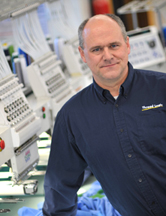One of the biggest challenges when purchasing custom logo embroidered apparel over the Internet is getting the proper sizing and fit. We at Thread Logic understand that challenge. We want your logo apparel to fit as well as you do. Because when you look good, we look good.
 One tool that is available for customers to help with that challenge is a size chart. For many people that is all the information they need in order to find something that will work for them and their employees. The size charts we provide come directly from the manufacturers are very helpful and accurate.
One tool that is available for customers to help with that challenge is a size chart. For many people that is all the information they need in order to find something that will work for them and their employees. The size charts we provide come directly from the manufacturers are very helpful and accurate.
But sometimes you may find yourself in a situation where you just absolutely have to try something on before making a decision. Ok, we get that too and have worked to make that process and simple as possible.
The best solution in that case is to get a blank sample of a shirt. We ship blank samples of polo shirts and button down shirts to customers all the time. Our blank sample process is to charge for those items up front and then credit you back when they are returned. That credit can be in the form of a credit to your credit card or we can credit your order as well.
There is a $5 charge for shipping and handling but that charge covers shipping both to you and back to us. After we ship the samples, we will email you a return label to get the package back to us.
We recommend not getting every size you think you might need however. That is really just overdoing it. Most people can get just a couple of sizes and figure out what is going to work best for them from there. For example, trying on a large size will tell you a lot of things. It will tell you if the large works or not. If it does, great, decision made. If it does not fit well, it will probably tell you if you need to drop down to a smaller size like a medium or move up to a larger size like an extra-large.
The biggest disadvantage of getting blank samples to try on is time. It takes time to ship out a blank sample and then make a decision. Sometimes, if there is an event or specific deadline, there may not be enough time to go through that process.
The best situation in which to get blank samples is when you have people to fit that might have challenges in finding the right size. Otherwise we recommend getting the size you would normally wear.
But getting blank samples is a great way to figure out exactly what you need and make sure the fit is something that will work for you.
If you would like to order a blank sample, you can call us at 800-347-1612, email us at customerservice@thread-logic.com, or place the order online.
If you choose to order blank samples online, place those items in our shopping cart. During the checkout process there is a field called “Special Instructions”. In that field enter “BLANK SAMPLES”.
The shopping cart will display a $15 shipping charge. We will adjust that to $5 after receiving your order













